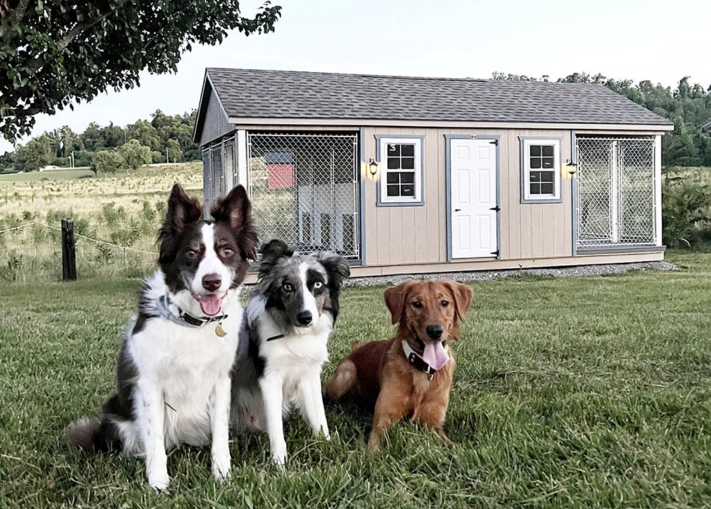Canine Kennel Choices – Make Smart Design Decisions
By Nikki Alvin-Smith
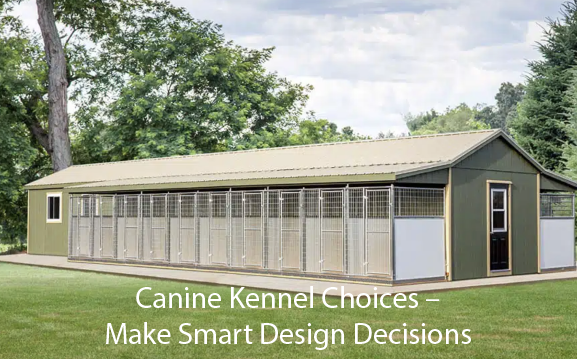
So you’ve decided to utilize the benefits of kenneling your family pet(s), breeding/working canines or plan to run or upgrade your dog housing options for a boarding or rescue business and are buying a kennel for residential or commercial use. Eager to take advantage of the kennel benefits of providing animals with shelter, security and safety, you take to the marketplace to figure out best kennel designs and price options. Trouble is, what do you choose?
It may be that you simply seek a kennel for boarding purposes for your beloved family pet while you are on vacation and are not quite certain what design features you should look for in the kennel box/run space offered for your pet’s home away from home.
Either way, smart choices in what you select for dog housing matters to the happiness and welfare of the canine residents. Remember, happy dog, happy owner! Both sides of the dog care experience matter. And a word to the wise, leading manufacturers in commercial grade kennels often offer many of the same professional grade features as standard in their residential product line too. So regardless of which market you are in, it’s well-worth learning about the key features that will make all the difference.
Easy Care Kennel Surfaces And Good Drainage Are Must Haves
As much as we love our canine companions they do tend to make a mess. Inevitable bodily functions that will need clean up are not limited to urine and feces production. You’ll encounter shedding hair, drooling and dribbling, and for breeding animals blood discharge. Yuk! So it makes sense that the environment the dogs occupy is one with sealed, easy clean floors and walls, great passive ventilation, with access to hot/cold water for deep clean tasks.
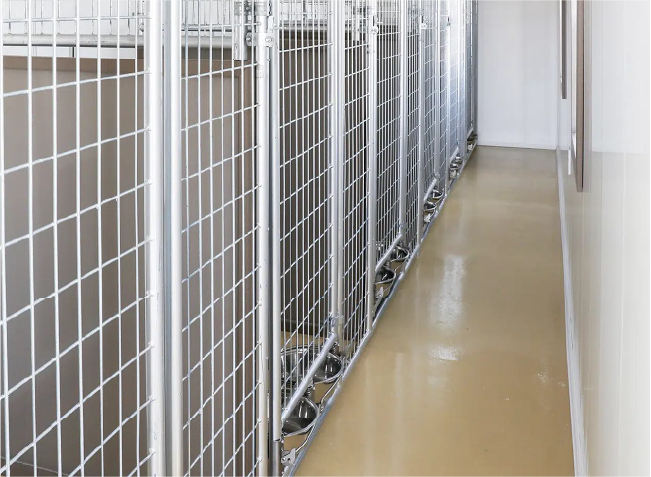
Why do old-fashioned kennels place drains for the kennel box in the center of where the dog will want to lay down? Whatever the initial design reason it was a flawed one, and good modern-day kennel design solves it by placing the drain at the exterior wall of the kennel box. Really good kennel designs also seal the drainage exit points by cladding down the pipe from a stainless-steel channel drain ( usually an upgrade). This eliminates the chance of water or other materials leaking at stress points in the drainage system over time. Connection points for pipes being one of those.
It's important to remember that poor hygiene in the kennel environment caused either by neglect, or by contamination due to poor drainage systems pose a real health hazard not just to the canine residents, but also the human caregivers.
Take for example what happened at the professional dog rescue center, Lincoln County Animal Shelter at Newport, Oregon in 2019. Staffers started becoming sick while caring for the hundreds of animals that come through the facility each year. The shelter was inspected and found to be contaminated with mold. The animals were immediately evacuated leaving only the outdoor spaces available for exercise periods. Director, Laura Braxling and her team had to move quickly to ensure proper care for the current ‘tenants’ – as well as the never-ending stream of incoming animals – during the transition to new quarters.
· Kennel Upgrades That Make Sense
There are many aspects of kennel living to consider that vary by individual need. A busy boarding kennel will likely want different features to a part-time use kennel used in the back garden for visiting family and friends pets or as a retreat for the family pet.
Here, in no particular order, are some kennels and run features to consider:
· Kennel Height Should Be Human Friendly
All kennels should be built with a person sized door for entry and access to the interior kennel boxes and exterior runs/pens should also be tall enough that an average height human does not have to bend down to work in the space. It is singularly miserable to work on a daily basis attempting to do a good cleaning job or handle the resident dogs when you are bent over double.
Ceiling height also plays an important role in ventilation. Air flow, whether passive or mechanical via an exhaust fan and/or ceiling fan, is always improved by having sufficient air flow within the building. Gable shutters ( preferably aluminum) and the correctly sized fan that is rated to work for the square footage of the structure all add important comfort factors and provide cleaner, healthier fresh air while also helping to mitigate the presence of any unpleasant odors.
· Incorporate Hot and Cold Weather Solutions
Nobody enjoys being too hot or too cold including your dogs. A mini-split heater and AC unit appropriately rated for the kennel area makes a huge difference to both the human caregiver and the animal residents experience.
· The Escapee Dogs
Out the front door, out the pen, through the floor or under or over a fence – escapee canines out on ‘the run from the run’ can cause major headaches for their trainers/caregivers/owners. The Houdini style antics that dogs are capable of are sometimes beyond comprehension and a tenacious puppy of any size can do major ‘chew damage’ to unprotected surfaces. My labrador puppies once managed to take the binding off ¾ off a large carpet within a matter of ¾ hour when I left them unsupervised to take in my favorite TV show. A costly mistake on my part! But thankfully they didn’t ingest material requiring a vet visit, they kindly just scattered the mess about the room.
Special upgrade features pertinent for use when housing large dogs, or service animals such as Working Military Dogs and K9s, are available such as welded low-gauge wire for containment that offers extra-protection from escape. I had a friend whose pair of Bull Mastiffs managed to chew through unwelded wire and escape when left alone for a few hours and defeated almost every type of kenneling attempt. Design features such as vinyl cladding and welded heavy duty wire would have eliminated this issue.
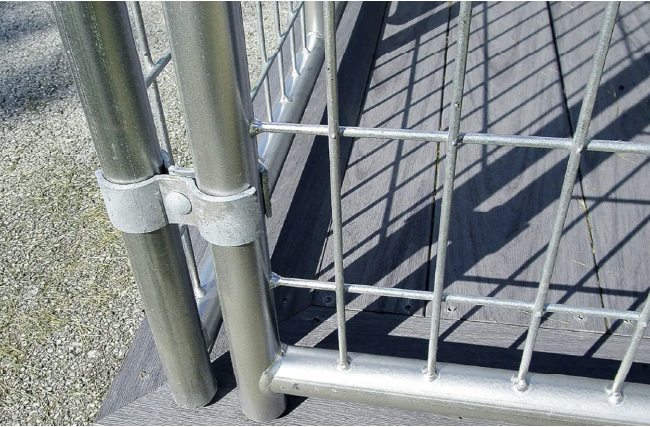
To help keep dogs calm and content consider adding solid wall partitions as privacy panels between kennel boxes.
Human-sized wire grilled entrance doors to the kennel unit that can be kept shut during hot weather use and when working inside the kennel are great options to prevent escape of rambunctious dogs.
Building for the needs of the specific canine clients that are anticipated to actually use the kennel is an important step in the kennel purchasing decision as retired professional canine handler for Search and Rescue and Fireman Billy Pruitt knows all too well. He and his wife Trish developed their own canine boarding and training operation Evolutionary K9 and it has become an extremely successful business.
In fact, their business became so busy the couple decided to expand their operation. When they went shopping for kennel structures, they made smart decisions. The couple generously share their process of business development and kennel choices here.
· Water Works and Electrical Packages
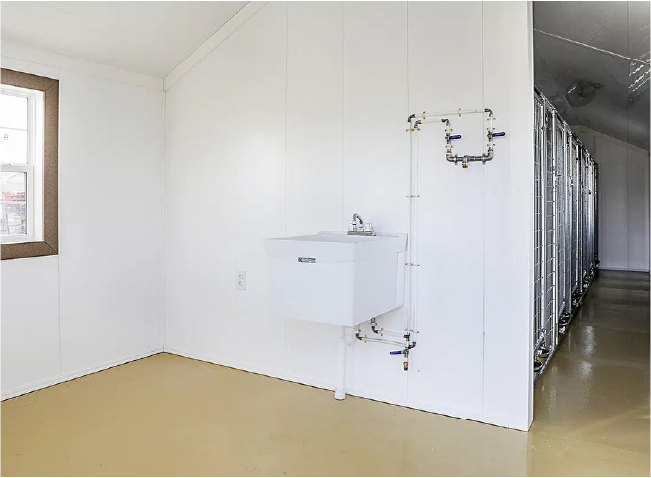
A kennel without running water service within the building will require a lot of extra labor to operate. While this set-up or lack thereof, may be fine for one or two dogs with a kennel only used intermittently, for larger kennel operations the daily dragging of hoses, water bucket lugging and time spent back and forth for water supplies soon becomes tiresome. An interior hose port together with a mini-split heater can also eliminate cold winter weather issues that will otherwise add to the misery as they bring with them the need to defrost faucets, drain hoses and break ice in standing water in buckets. It’s always wise to plan ahead.
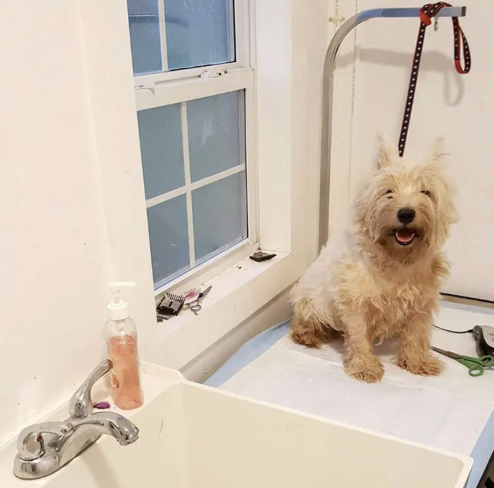 To alleviate all the additional work consider adding a hot and cold-water system to service the structure. Electrical packages and rough plumbing, sinks for bathing dogs and a small galley washroom can make life much easier for the canine caregiver.
To alleviate all the additional work consider adding a hot and cold-water system to service the structure. Electrical packages and rough plumbing, sinks for bathing dogs and a small galley washroom can make life much easier for the canine caregiver.
· Don’t Forget Outside Maintenance Issues
Modern day materials mean that siding choices are extensive in color, style and durability. Even if you opt for a more traditional wood finish the staining products now available on the market and their range of color options offer longevity with up to 15-year warranties for some.
It is well worth the extra effort of checking out the details of what the actual kennel structure you buy is constructed of and what warranties apply. The less time you need to spend keeping the structure looking good and maintaining its integrity the more free time you’ll have to spend with your dogs doing the activities you love.
An integral raised floor exercise pen area as an adjunct part of the kennel is a useful upgrade. Consider including the option of heavy black coated wire for run floors or Tenderfoot Flooring. Tenderfoot Flooring is a very popular feature as is more comfortable on the dog’s feet than traditional wiring. Other considerations are the upgrade to
Polyurea Coated runs, which add an easier-to-clean surface than or solid composite decking solutions.
· Multiple Entry Points
It may not seem like a big deal to have just one access point to the kennel but in reality it is limiting factor when working with larger numbers of canines.
For example, say you are cleaning out the kennel boxes and working inside the structure and you’ve sensibly sent the resident canines out of the box space through the hatch door to the outside roofed ( hopefully, because this protects the dogs from hot sun and inclement weather) deck area into their pen space and closed the hatch door behind them.
While you are cleaning up someone comes to collect a dog you are boarding or wants to take a K9 out for a training session. If you have a wired gate to each pen area then the dog can be taken off and brought back without interrupting housekeeping proceedings.
Are You Spoiled For Choice In Kennel Designs and Upgrades?
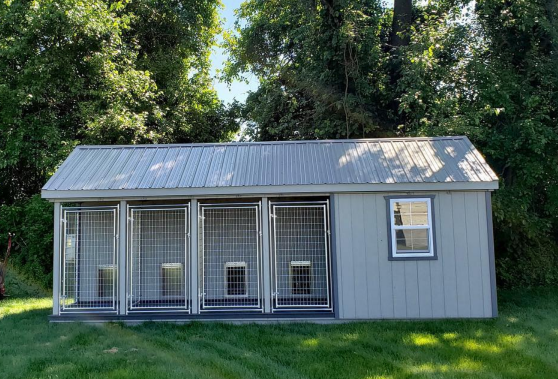
Frankly, the answer to that is a hard yes! The task of what features to select, how much they’ll add to the ultimate price point and what benefits they have are all factors that an informed buyer needs to know to make their best decision.
Shortcuts to achieving best decision both efficiently and with accuracy on pricing that includes set up as well as hands-off delivery of the kennel is easy by following a few simple steps:
1. Shop online from an established and reliable source that offers an extensive range of kennel designs and optional upgrades and will provide ‘to the penny’ pricing and a straightforward buying and delivery process. Be certain to compare ‘apples to apples’ in terms of quality of component materials and craftsmanship.
2. Call the company or email (calling can be best as it allows questions back and forth to be quickly addressed making decision time fast). A good company will educate you, rather than offer a hard sell.
3. Buy it! A straightforward contract should clearly detail specifics of what is included, when payments are due and what the timeline for delivery is to be and provide site preparation guidelines.
